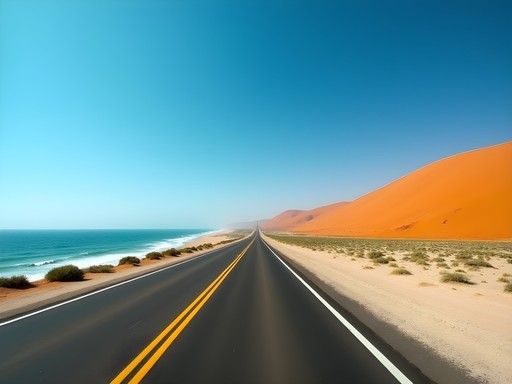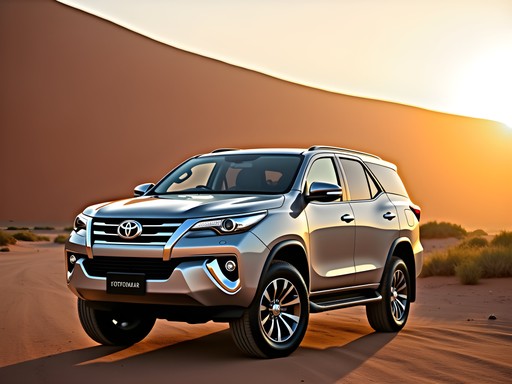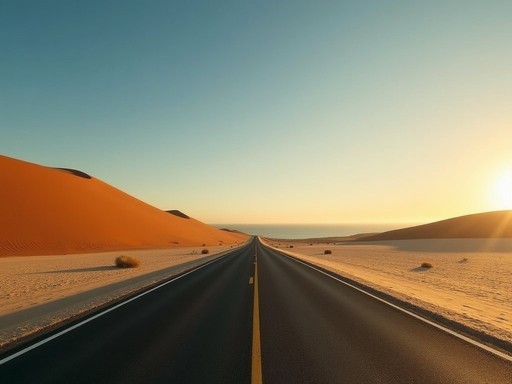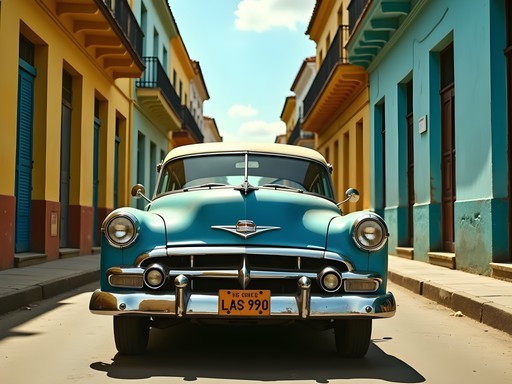Disclosure: This article contains affiliate links. We may earn a commission from purchases at no extra cost to you, which helps our travel content.
The first time I saw the Atlantic Ocean crash against the edge of the Namib Desert, I literally pulled my rental car over and just stared. How could something so contradictory exist? Deep blue waters on one side, towering sand dunes on the other, with just a narrow ribbon of asphalt running between these two vastly different worlds. The 30-kilometer (19-mile) coastal drive connecting Walvis Bay and Swakopmund isn't just transportation – it's one of Namibia's most surreal experiences. As someone who's driven coastal routes from California to Colombia, I can honestly say nothing prepared me for this otherworldly journey where the oldest desert on earth meets the sea. Whether you're a solo adventurer with limited time or a photographer chasing that perfect shot, this short but spectacular drive deserves your full attention – and I'm going to show you exactly how to make the most of it.
The Basics: Route Options & Transport Choices
Let's start with the practical stuff. The C14 highway connecting these two coastal towns is well-maintained and fully paved – a welcome relief after some of Namibia's more challenging gravel roads. You've got several options for making this journey:
Self-Drive: My personal recommendation. Renting a car gives you the freedom to stop whenever those jaw-dropping vistas demand it (trust me, they will). Standard 2WD vehicles are perfectly fine for this route, no need for a 4x4 unless you're planning desert detours. I rented my compact car from the Walvis Bay Airport for about $40/day, which included basic insurance.
Shuttle Services: If you're not comfortable driving, several companies operate regular shuttles between the towns. Expect to pay around N$150-200 (≈$10-13 USD) one-way. The downside? Limited stopping opportunities.
Taxi: For solo travelers, this can actually be cost-effective. A one-way trip runs about N$300-350 (≈$20-23 USD). I've found that many taxi drivers are willing to make brief photo stops if you negotiate upfront.
Local Buses: The most budget-friendly option at around N$50 (≈$3.50 USD), but schedules can be unpredictable and you'll miss those impromptu photo opportunities.
The drive itself takes only 30-45 minutes without stops, but I'd recommend allowing at least 2-3 hours to truly appreciate the journey. The road hugs the coastline the entire way, offering continuous views of both the desert and ocean – a photographer's dream and a nature lover's paradise.

💡 Pro Tips
- Fuel up before leaving – there are no gas stations between the two towns
- Download offline maps as cell service can be spotty along certain stretches
- The road is busiest during weekday rush hours (7-8am and 4-5pm)
Must-Stop Viewpoints Along the Way
What makes this short drive so special are the incredible stopping points that showcase Namibia's contrasting landscapes. Here are my favorite spots you shouldn't miss:
Dune 7: Just outside Walvis Bay, this is one of the highest sand dunes in the world at over 380 meters. I'll admit – climbing it nearly killed me, but the views were worth every burning step. Bring plenty of water and your hiking sandals if you attempt the climb. The sand gets scorching hot by midday!
Salt Pans: The massive white salt pans outside Walvis Bay create an almost lunar landscape. On my visit last year, I was lucky enough to catch them when they turned pink from algae blooms – an incredible backdrop for photos.
Flamingo Viewpoint: About 10km outside Walvis Bay, there's a small pullover where you can often spot hundreds of flamingos feeding in the shallow coastal waters. I spent nearly an hour here watching their graceful movements against the desert backdrop.
Shipwreck Point: Several rusted shipwrecks dot the coastline, testament to the dangerous Atlantic currents. The most accessible is about halfway between the towns – you'll see cars pulled over to photograph it.
Langstrand Beach: This long stretch of beach between the towns is where the desert literally meets the ocean. I've never seen anything quite like watching seals lounging on sand dunes! It's also a popular spot for locals on weekends.
What amazed me most was how quickly the landscape transforms. One minute you're surrounded by desert, the next you're watching fishing boats in the harbor. The juxtaposition is what makes this drive so uniquely Namibian.

💡 Pro Tips
- Visit the flamingo viewpoint early morning for the best light and bird activity
- Bring a lightweight jacket – the coastal winds can be surprisingly chilly even on warm days
- Keep your camera ready for jackals and other desert wildlife that sometimes appear near the road
The Skeleton Coast Detour
If you have extra time, consider extending your coastal drive north of Swakopmund to experience the legendary Skeleton Coast. This stretch feels like driving on another planet – I'm not exaggerating when I say it's one of the most hauntingly beautiful places I've ever visited.
The first 70km north of Swakopmund is accessible with a regular vehicle, no permits needed. Beyond that, you'll need special permits and a 4x4. Even on that first accessible stretch, you'll get a taste of why sailors once called this the 'Gates of Hell' – fog banks rolling in from the ocean, more shipwrecks emerging from the sand, and endless desolation.
During my visit last year, I drove about 50km north of Swakopmund and was rewarded with complete solitude – just me, the crashing waves, and desert extending to the horizon. I packed my binoculars which proved invaluable for spotting distant seal colonies and shipwrecks without having to trek through the sand.
One important note: if you venture onto the Skeleton Coast, be extremely well-prepared. Cell service disappears quickly, and there are no services whatsoever. Bring extra water, snacks, and make sure your vehicle has a full tank of gas. The remoteness is part of the appeal, but it requires respect and preparation.
The stark beauty of this coastline – with its salt-crusted plains, fog-shrouded beaches, and the constant soundtrack of waves – creates an atmosphere that's both eerie and magnificent. It's a reminder of nature's raw power and our relative insignificance in the face of such vast wilderness.

💡 Pro Tips
- Check weather conditions before heading to the Skeleton Coast – fog can reduce visibility dramatically
- Tell someone your plans if driving north of Swakopmund
- The Zeila shipwreck (about 50km north of Swakopmund) is one of the most photogenic and accessible wrecks
Comparing Walvis Bay & Swakopmund
After driving between these towns multiple times during my stay, I noticed they each have distinct personalities despite being so close together.
Walvis Bay feels more industrial and working-class, centered around its busy port. The town has fewer tourist amenities but offers incredible access to natural attractions like the massive dune fields and lagoon teeming with marine birds. Accommodation tends to be slightly cheaper here, and you'll find more locals than tourists in the restaurants. I stayed at a lovely guesthouse near the lagoon for about N$800 (≈$55 USD) per night.
Swakopmund, by contrast, embraces its role as Namibia's premier beach resort. The German colonial architecture gives it a distinctly European feel – walking down Sam Nujoma Avenue with its cafes and boutiques, I sometimes forgot I was in Africa until I glimpsed the desert at the end of the street. The town has significantly more tourist infrastructure, adventure outfitters, and upscale dining. Expect to pay about 20-30% more for comparable accommodation.
So which should you base yourself in? It depends on your priorities:
- Adventure activities: Swakopmund wins for easy access to sandboarding, quad biking, and skydiving operators
- Wildlife & nature: Walvis Bay has the edge with its lagoon (flamingos!), nearby dunes, and dolphin cruises
- Dining & nightlife: Swakopmund offers more variety and upscale options
- Authentic local experience: Walvis Bay feels less touristy and more genuinely Namibian
Personally, I split my time between both. I started in Walvis Bay to explore the lagoon and dunes, then moved to Swakopmund for adventure activities and better restaurant options. The short drive between them makes this combination easy.

💡 Pro Tips
- Book accommodation in advance during Namibian school holidays (December-January and April-May)
- Many adventure operators offer pickup from either town, so your base doesn't limit activity options
- Walvis Bay has better supermarkets if you're self-catering
Adventure Breaks Along the Route
While the coastal drive itself is relatively short, the area between and around Walvis Bay and Swakopmund offers some of Namibia's most exhilarating adventure opportunities. During my week exploring the region, I broke up my drives between the towns with these unforgettable experiences:
Sandboarding the Dunes: Just outside Swakopmund, several operators offer sandboarding on the massive dunes. I'm an experienced snowboarder, but sandboarding has its own learning curve! Standing descents reach incredible speeds, while lying down on a waxed board feels like sledding at warp speed. Most tours include transport from either town, equipment, and instruction for around N$600-800 (≈$40-55 USD).
Paragliding: One of my absolute highlights! Taking off from the dunes and soaring over the point where desert meets ocean created some of the most spectacular views I've ever witnessed. The unique thermal conditions here make for exceptionally stable flights. I went with Namib Sky Adventures, who picked me up from my Swakopmund hotel.
Living Desert Tours: These specialized tours reveal the surprising amount of wildlife adapting to the harsh desert environment. My guide showed us transparent geckos, dancing white lady spiders, and the famous sidewinding adders – all creatures I would have completely missed on my own.
Quad Biking: For those seeking adrenaline, quad bike tours let you venture deep into the dune fields where vehicles can't go. I rented a action camera specifically for this activity, which was perfect for capturing hands-free footage while navigating the sandy slopes.
Dolphin Cruises: Departing from Walvis Bay's harbor, these boat trips offer close encounters with dolphins, seals, and sometimes whales against the backdrop of the desert. The marine wildlife here is surprisingly abundant thanks to the nutrient-rich Benguela Current.
What makes these activities so special is their accessibility – you can easily fit several into even a short stay, using the coastal road as your connector between adventures.

💡 Pro Tips
- Book adventure activities at least a day in advance during peak season
- Many operators offer package discounts if you book multiple activities
- Early morning activities often have better conditions (less wind) and more wildlife sightings
Final Thoughts
As I made my final drive between these twin coastal towns, watching the setting sun turn the desert dunes to gold on one side while painting the Atlantic waves purple on the other, I couldn't help but reflect on how this short stretch of road encapsulates what makes Namibia so special. It's a land of extremes and contradictions – where ancient desert meets ocean, where German architecture stands against African landscapes, where adventure and tranquility exist side by side. Whether you're making a quick transfer or turning the journey into a multi-day adventure, the coastal road between Walvis Bay and Swakopmund offers a glimpse into Namibia's soul. So rent that car, roll down the windows, and take your time. Pull over often. Feel the cool Atlantic breeze mix with hot desert air. And remember that sometimes the journey between destinations becomes the most memorable part of all.
✨ Key Takeaways
- The coastal drive takes only 30-45 minutes but deserves at least half a day with stops
- Both self-drive and guided options are available, but self-drive offers the most flexibility
- The contrast between desert and ocean creates unique adventure opportunities not found elsewhere
- Both towns have distinct personalities - consider splitting your stay between them
📋 Practical Information
Best Time to Visit
year-round (June-August offers mild temperatures; December-January has warmest ocean temperatures)
Budget Estimate
$50-100/day excluding activities
Recommended Duration
1-3 days
Difficulty Level
Easy
















Comments
tripguy
Going there next month! Is it better to stay in Walvis Bay or Swakopmund? We'll have 3 nights and want to do some desert activities plus the boat tour to see seals.
John Hart
I'd recommend Swakopmund for accommodation - more restaurant options and colonial architecture gives it more character. Walvis Bay is better for the lagoon wildlife but it's an easy day trip. The drive between them is only 30 minutes.
tripguy
Thanks John! Swakopmund it is then.
backpackking
Those flamingos at Walvis Bay were incredible! Did anyone else see them?
Kimberly Murphy
Lillian, your post brought back such vivid memories! I did this drive at sunrise last year and the way the morning light hit those dunes was MAGICAL. For anyone planning this journey, I highly recommend bringing binoculars for wildlife spotting - we saw jackals and several bird species along the way. Also, the Salt Works near Walvis Bay is an underrated stop - those pink evaporation ponds make for stunning photos. The coffee shop at Dune 7 outside Walvis Bay makes a perfect first stop if you're heading north. Their cappuccinos paired with that view? Absolute perfection!
dreamwanderer
Thanks for the coffee tip! Always need my morning caffeine fix.
Marco Suzuki
Excellent breakdown of the route options, Lillian. I completed this journey last year while researching coastal desert ecosystems. For those considering public transport, note that the shared taxis are efficient but often quite full. If you're carrying photography equipment like I was, you might want to consider a private transfer or rental. The Skeleton Coast detour is absolutely worth the extra time - the shipwreck remains create an almost post-apocalyptic landscape that contrasts dramatically with the pristine dunes. I'd add that early morning drives offer the best lighting conditions for photography, before the midday glare washes out the desert colors.
moonnomad
Marco - did you need a 4x4 for the Skeleton Coast detour or is a regular car OK?
Marco Suzuki
For the accessible parts near Walvis Bay and Swakopmund, a standard car is fine as the roads are well-maintained. If you're venturing further north past Henties Bay, then 4x4 becomes essential. I used my guidebook which has detailed maps showing which sections require 4WD.
adventureblogger
Those sunset photos are INCREDIBLE! The golden dunes against the blue ocean - wow! Adding this to my bucket list right now!
coffeeguide
Just got back from Namibia last month and did this exact drive! The contrast between desert and ocean is mind-blowing. We stopped at Dune 7 on the way and climbed to the top - exhausting but totally worth it for the views. The salt pans were another highlight we almost missed. Did anyone else notice how the fog rolls in so quickly in the afternoons? Made for some eerie driving but also beautiful photos.
springgal1113
Yes! That fog came out of nowhere when we were there too. Spooky but beautiful!
coffeeguide
Right? Our guide said it's called the 'Cassimbo' by locals. Apparently it helps the desert plants survive!
escapehero
This drive is absolutely incredible! Pro tip: we pulled over at one of the unmarked turnoffs about halfway between the towns and had the whole beach to ourselves. Saw seals playing in the waves and found some interesting pieces of driftwood. Just be careful not to drive on the actual beach - the sand can be deceptive and you'll get stuck fast!
phototime
Is it worth renting a car for this stretch or are there good tour options? Not super confident driving in unfamiliar countries!
Frank Garcia
The road is actually really good - paved and well-maintained. If you're nervous, there are half-day tours from both towns that cover the scenic route with stops. But having your own car gives you freedom to linger at the best spots!
Nicole Russell
Lillian, your post brought back so many memories! I did this drive solo last year and it was unforgettable. For anyone planning this trip, I highly recommend the Dune 7 stop just outside Walvis Bay - it's the tallest dune in Namibia and climbing it at sunrise was magical (though exhausting!). Also worth mentioning is the salt pans where you can sometimes catch those iconic flamingo photos. Between the two towns, I actually preferred staying in Swakopmund for its German colonial architecture and better restaurant scene, but Walvis Bay had more authentic local vibes. Can't wait to go back!
Lillian Diaz
Thanks Nicole! Dune 7 at sunrise is such a great tip. The light on the sand is incredible at that hour.
wanderace
How's the cell service along this route? Need to stay connected for work emails.
sunnyace
It's pretty good between the towns, but can get spotty if you detour inland. I used my portable hotspot and had no issues at all.
Venture X
Premium card with 2X miles, $300 travel credit, Priority Pass